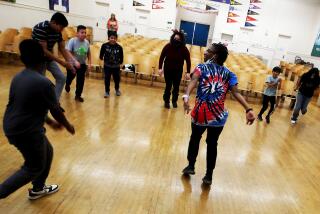Massachusetts Schools Learn to Cut Costs : Education: Districts have reduced or eliminated spending for materials and books to make ends meet during the state’s fiscal crisis.
- Share via
WHITMAN, Mass. — First-grader Alex Kanelopoulos laboriously printed sentences using the day’s spelling words on a large sheet of computer paper.
The 6-year-old was running out of room, but he couldn’t turn the paper over. The paper was donated by a local business, and the other side was covered with a dense printout labeled “Back-Up Customer Information Report.”
The Whitman school budget allocated no funds for paper or other classroom supplies this year--or next. And this South Shore town isn’t unique.
Across Massachusetts, school districts have reduced or eliminated spending for materials and books to make ends meet during the state’s fiscal crisis.
“We’re the first generation in our country to look at our kids to say ‘Have less. Take less than we got,’ ” said Jim Wilcox, a Fall River history teacher and president of the city’s teachers union.
“They’re going to hold us responsible.”
Youngsters bring their own crayons to draw on used paper donated by businesses. Parents hold fund drives to buy textbooks. Teachers dig into their own pockets to buy basic supplies such as glue, pens, pencils, rulers and tape.
“As school budgets get ratcheted down further and further, nonpersonnel areas are the first to get cut,” said Stephen Wollmer, spokesman for the Massachusetts Teachers Assn.
Massachusetts has been $1 billion in the red for each of the last two years, one of more than two dozen states across the country that have cut budgets or face whopping deficits. New York faces a potential gap of $6 billion. California has cut $2.7 billion.
In a statewide survey, the Massachusetts Teachers Assn. found that many communities cut their supply budgets by 25% to 50% this year. For some, it was much more.
Two years ago, Whitman budgeted $147,000 for supplies, textbooks and workbooks, Supt. John Pini said. But that was before town voters twice rejected proposed overrides of the tax limitations set by the state’s Proposition 2 1/2.
Since then, the district has laid off 26 teachers and expects to lay off about 30 more, Pini said. Spending on supplies could mean cutting more jobs.
Many teachers now buy one workbook, then photocopy lessons for use in class. But even that approach can backfire.
In Hanson, “our building principal came to us a month ago and said there’s no more copy paper,” said kindergarten teacher Susan Thevenin.
Eventually, faculty got enough paper to finish out the year, “but we’re very, very frugal about what we copy,” she said.
Districts increasingly turn to parents for help. In Whitman, parents bought nearly 100 phonics books at about $12 apiece for the system’s first-graders. Most responded to teachers’ requests to send their kids to school with about $20 worth of supplies, and a few sent extra items for youngsters whose parents didn’t respond.
Teachers also make up the difference. Wollmer estimated that the average teacher spends $200 to $300 out of pocket every year for school supplies. Some spend much more.
Lanice Jacoby and Steve Carme, a married couple who both teach grade school in the Cambridge suburb of Arlington, said they spent $6,000 on their students last year.
While much of the money went for teacher guides and enrichment activities, “we have to spend more and more money on basic supplies,” Jacoby said.
Budgets for supplies also cover textbooks, so purchases have dwindled there as well.
Many districts report that their texts are older than the students using them. “Jimmy Carter is the last President mentioned in our history books,” wrote a Middleboro teacher responding to the MTA’s survey.
Educators said the lack of a pen here or a pad of paper there won’t, in itself, keep kids from learning. But they say the shortages have a cumulative impact.
“My children are not getting the education I did,” said teacher Anne Sullivan, a Whitman native whose two youngsters attend the town’s schools.
More to Read
Sign up for Essential California
The most important California stories and recommendations in your inbox every morning.
You may occasionally receive promotional content from the Los Angeles Times.













